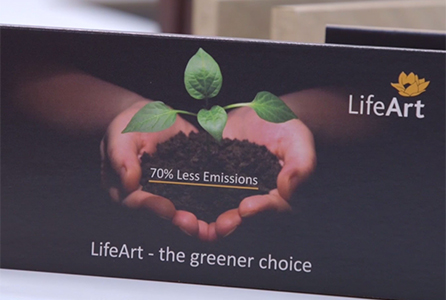Lifeart: an environmentally-friendly solution
It may not be a topic that many like to think about, but death is an inevitable part of life. Funerals take place around the world every day, with 35 million coffins sold each year. An Australian company, with factories also in the UK and China, has created a greener way to celebrate life and new life with more environmentally-friendly coffins.

Friday, 01 Jun 2018 12:48 GMT

Lifeart coffins can resemble traditional coffins, with shapes of the caskets matching the tradition of countries across the world
With the news breaking that The Competition and Markets Authority is reviewing costs to make sure that people are not getting a bad deal when paying for a funeral plan or funeral, Lifeart coffins are more affordable. The Treasury are also focusing on concerns for pre-paid funeral plans, as family members could face higher costs after their relative has died.
Using technology from the print industry, Lifeart uses greener substrates than the traditional MDF (medium-density fibreboard) or particle board that is used to manufacture traditional coffins. The materials are thinner and lighter, but can hold up to a tonne, making the coffins easier to lift and carry. The Lifeart coffins are cut by a Zund cutting table and then glued by an automated machine. The bare product is then wrapped with prints produced by an Agfa Jeti Mira flatbed printer by hand. The designs can resemble traditional coffin wood or have a print that you have designed yourself.
Mike Greehan, chief executive officer and executive chairman of Lifeart, explains: “We try and keep our key facts simple, Lifeart produces 97 percent, when it’s cremated, less greenhouse gasses than MDF, it’s about 82 percent against particle board. When a coffin is cremated, a traditional MDF coffin produces nitrous oxide, which creates the hole in the Ozone layer.

The second key aspect is that we require 80 percent less trees, timber or pulp, to produce a coffin versus a coffin made from MDF or particle board”
“The second key aspect is that we require 80 percent less trees, timber or pulp, to produce a coffin versus a coffin made from MDF or particle board. In the world there are 35 million coffins sold every year and that’s a lot of timber. The reduction in pollution as a result of the Lifeart coffins is very big for the planet.”
The personalisation aspect of Lifeart coffins offers family and friends a different way to commemorate a loved one. Greehan notes that it is fulfilling work and comments: “A lady, I won’t mention her name, but her passion was travel—you get a bit emotional when talking about these stories—and she died quite young of cancer. Her mother and father had a coffin personalised with photos all over the coffin, lots and lots of little photos, and I remember Natalie, one of the founders of Lifeart, sitting there all hours of the night, getting the design right.
“When the coffin was shown at the funeral everyone knew what it was about, and it really gives people, not only in the family, but the broader gathering of people who come to the funeral the chance to grieve in a very different way because it allows you to talk about things you didn’t think you’d talk about because the coffin sits there and there’s no emotional aspect, whereas our coffins give you that chance to grieve in a very different way.”

Cremating a Lifeart coffin is more environmentally friendly than a traditional coffin made from MDF or particle board
Lifeart are aware their product is not something that has ever been presented to the market before and will be striving to be present across the world, starting with America next year. Greehan also says that the way forward for production is automation and explains: “We are looking at automation in a much bigger way which no one has done in the industry before.”
The company not only wants to reduce the pollution from the manufacturing and cremation of coffins, but also the cost. Funeral poverty has grown as the price of a funeral has increased, and Greehan hopes that the Lifeart solution will reduce this discrimination because it is more cost effective.
While it may not be the easiest topic to talk about, knowing that you will be making a small difference at the end, providing a better future for your children and grandchildren may be a comforting thought. The ability to personalise the coffins thanks to the print industry will also change the way people grieve, giving the family and friends left behind some comfort. Lifeart will be providing that support.
If you have an interesting story or a view on this news, then please e-mail
news@signlink.co.uk
Follow Genevieve on:
